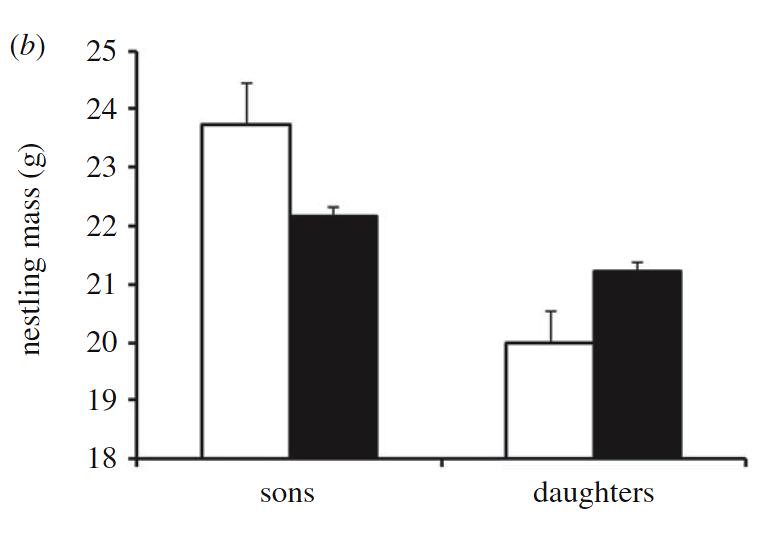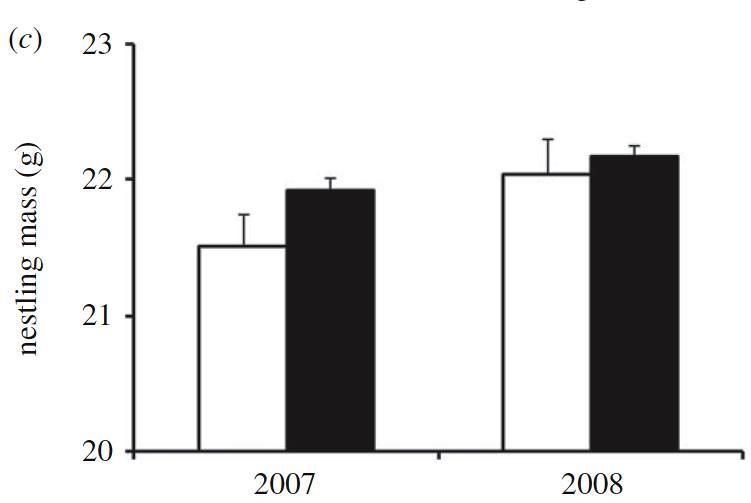Journal Club: The economics of tree swallow brood sex ratios
Tree Swallow brood sex ratios
SUMMARY: Tree swallows reveal that brood sex ratios are an economic balancing act with far-reaching evolutionary consequences
![]() Skewed sex ratios have been widely discussed in the news. But a demographic imbalance in the sexes is not purely a human phenomenon: it can occur throughout the animal kingdom.
Skewed sex ratios have been widely discussed in the news. But a demographic imbalance in the sexes is not purely a human phenomenon: it can occur throughout the animal kingdom.
Several studies have shown that offspring sex ratios apparently are not due to chance, in birds at least. In one especially elegant study, female Gouldian finches, Erythrura (Chloebia) gouldiae, choose the sex of their chicks based on the plumage colour of the father’s head. Further, a “mixed marriage” in this species causes the female to experience very high stress levels, which may be the triggering mechanism whereby she exerts control over her chicks’ sex. But might other factors be involved in a female bird’s choice over her chicks’ sexes?
Variation in the ratio of sons to daughters is an important element in evolutionary theory. For example, when the potential realised benefits are greater for rearing one sex, that sex should be produced in excess. Sons are more beneficial to mothers because they have the potential to produce far more grandchildren than can daughters. More grandchildren correspond to a greater genetic contribution to future generations — the ultimate evolutionary goal. But the tremendous variation in reproductive success makes sons a risky investment: unlike poor quality daughters, poor quality sons generally do not reproduce at all.
Similar to potential benefits, the costs of raising sons and daughters are unequal, too: daughters are less costly to raise than sons, requiring fewer resources to reach maturity. Unlike sons, daughters — if they survive — nearly always reproduce. So to use gambling as an example, daughters represent a better bet, evolutionarily speaking, but provide smaller payoffs without the chance to win the grand jackpot that even one high quality son may provide.
Based on this information, the prediction is that mothers in better condition — whether due to good genes or because the environment is good — will produce more sons than daughters, whereas mothers in poorer condition will produce more daughters than sons. Further, mothers in poorer condition are unable to provide adequate resources so their sons will be less competitive as adults and thus, less likely to reproduce.
This prediction sounds reasonable, but is this really what happens?
Beginning in 2004, three researchers — Renaud Baeta, Marc Bélisle and Dany Garant — from L’Université de Sherbrooke in Quebéc, Canada, investigated the effects of environmental variations and maternal age on brood sex ratio in tree swallows.
Tree swallows, Tachycineta bicolor, are small passerines that breed throughout much of North America. Unlike some swallow species that construct their nests out of mud, tree swallows are easy to work with because they nest in cavities. Since natural cavities are limited and diminishing in number, these birds happily accept bluebird nestboxes (this story includes pictures of bluebirds and their nestboxes). This fondness for manmade nest boxes makes this species easy to monitor and work with.
Even though tree swallows are socially monogamous birds, DNA studies reveal that they are not very faithful: of all bird species studied, tree swallow broods have amongst the highest rates of extra-pair paternity documented so far (doi:10.1046/j.1365-294X.2002.01613.x). Thus, males have a highly variable reproductive success (doi:10.1093/beheco/5.2.123), especially compared to females, which produce between 4 and 7 eggs per clutch. Additionally, previous studies have shown that nestling body condition strong affects the adult bird’s reproductive success (doi:10.1642/0004-8038(2001)118 [0176:VIGONT]2.0.CO;2) and that breeding females adjust the sex ratio of their brood based on their own body condition (doi:10.1046/j.1365-294x.2000.00980.x). So clearly, body condition is very important to the breeding biology and natural history of this species.
Based on this information, the Canadian research team hypothesized that a biased sex ratio occurs in tree swallows when maternal condition affects offspring condition. To test their hypothesis, the research team studied tree swallows breeding in 400 nest boxes that were equally distributed amongst 40 farms in Quebéc. During three consecutive breeding seasons (2006-2008), the team recorded and measured variations in annual hatch dates (figure 1a) and nestling fledging rate (figure 1b):

The above figures show that 2008 had the earliest hatching and the highest fledging rate of the three years documented, whilst 2006 had the lowest fledging rate (figure 1, larger view).
Between 2006 and 2008, the team collected a drop of blood from 2215 nestlings or tissue from dead nestlings and unhatched eggs from 603 broods to identify sex using DNA sequencing techniques. After analysing those data, the team found a significant relationship between brood sex ratio and maternal age: inexperienced second-year (SY) females (white bars) had more daughters and fewer sons than did experienced after second-year (ASY) birds (black bars; figure 2a, larger view):

The team also found that maternal age affected nestling mass: sons of SY females (white bars) were much heavier than those produced by ASY females (black bars) whilst SY daughters were much lighter than ASY daughters (figure 2b, larger view):

But environmental conditions had an even greater effect than maternal age. Even though the masses of SY and ASY nestlings were similar in 2008 (an exceptionally good season for tree swallows), SY females produced smaller nestlings than ASY females in 2007 (figure 2c, larger view):

Further analyses of the data revealed that brood size had a negative relationship to nestling mass in both 2006 and 2007, but not in 2008, indicating that 2008 was an exceptionally good year for tree swallows. Yet on average, sons were always heavier than daughters in every season. (It is interesting to note that brood sex-ratio had no effect on nestling mass.)
This study found that, all things being equal, maternal age strongly affected nestling mass: nestlings produced by SY females had greater variation in mass between sons and daughters than did nestlings produced by ASY females. Nestling sex ratio was also affected by maternal age: SY females produced fewer sons than did ASY females — but this effect disappeared when environmental conditions were exceptionally good.
So female tree swallows’ reproductive “decisions” look like this: if the environmental conditions are excellent, then they produce equal numbers of sons and daughters. But if environmental conditions are average or poor, then maternal age takes precedence. If the female is young and inexperienced, she produces more daughters than sons so excessive demands are not made on her health that might impinge upon her future reproductive potential. Because heavier sons will grow up to be high quality males with a high reproductive success, a young female will invest heavily in her sons — at the expense of her daughters. However, if the female is older and experienced, she is unlikely to survive until the following year, so she produces an equal ratio of sons and daughters, invests heavily in raising all her chicks, and distributes resources more equitably between her sons and daughters so her daughters also grow up to be high quality mates.
Not only are these findings interesting on their own, they also provide insight into the behavioural ecology of other animals — yes, even humans’. But another interesting wrinkle in this story is the idea that avian brood sex ratios could be a particularly sensitive tool for assessing and monitoring annual variations in the quality of the local environment.
NOTE: mirrored from here.
Source:
Renaud Baeta, Marc Bélisle & Dany Garant (2011). Importance of breeding season and maternal investment in studies of sex-ratio adjustment: a case study using tree swallows. Biology Letters doi:10.1098/rsbl.2011.1009
Additional citations:
Griffith, S., Owens, I., & Thuman, K. (2008). Extra pair paternity in birds: a review of interspecific variation and adaptive function. Molecular Ecology, 11 (11), 2195-2212 doi:10.1046/j.1365-294X.2002.01613.x
Peter O. Dunn, Linda A. Whittingham, Jan T. Lifjeld, Raleigh J. Robertson, & Peter T. Boag (1994). Effects of breeding density, synchrony, and experience on extrapair paternity in tree swallows. Behavioral Ecology, 5 (2), 123-129 doi:10.1093/beheco/5.2.123
John P. McCarty (2001). Variation in growth of nestling tree swallows across multiple temporal and spatial scales. Auk, 118, 176-190 doi:10.1642/0004-8038(2001)118 [0176:VIGONT]2.0.CO;2
Whittingham, L., & Dunn, P. (2000). Offspring sex ratios in tree swallows: females in better condition produce more sons. Molecular Ecology, 9 (8), 1123-1129 doi:10.1046/j.1365-294x.2000.00980.x
.. .. .. .. .. .. .. .. .. .. .. ..
twitter: @GrrlScientist
facebook: grrlscientist
email: grrlscientist@gmail.com
